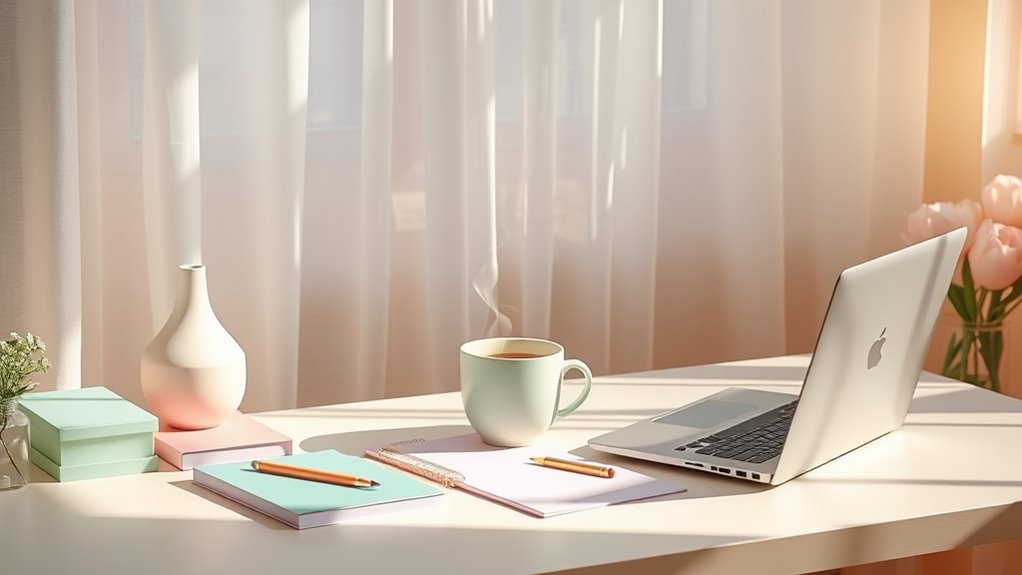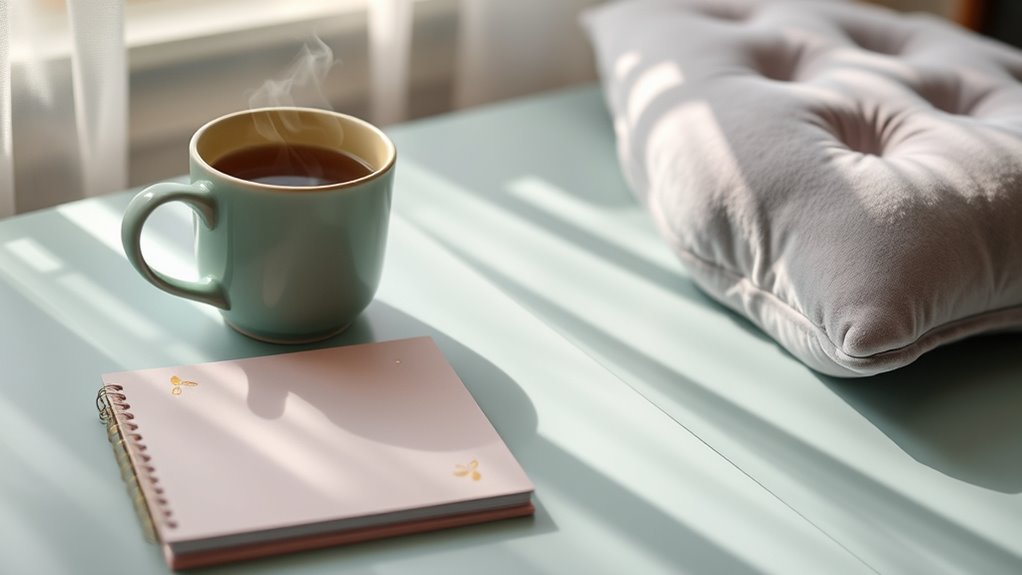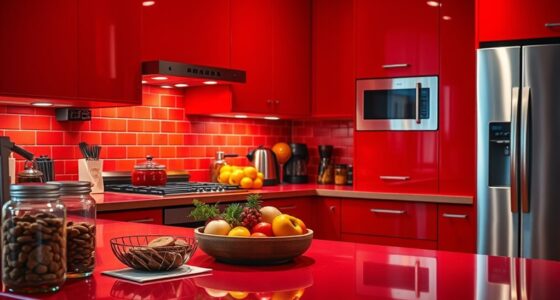Pastel tones aren’t just calming—they secretly energize your brain by boosting your mood and fostering mental clarity. Light pinks, blues, and lavenders help you relax while gently activating your reward centers, sparking happiness and motivation. These soft hues influence your emotions subconsciously, creating spaces that support focus and emotional balance. If you want to discover how to harness their full potential for your environment, you’ll find plenty of inspiring insights ahead.
Key Takeaways
- Pastel shades activate the brain’s reward centers, boosting happiness and motivation subtly.
- Soft pastel tones energize without overwhelming, fostering focus and emotional balance.
- Light pinks, blues, and lavenders serve as subconscious cues influencing mood positively.
- Pastel accents can enhance mental clarity and creativity in interior and fashion design.
- Their gentle vibrancy lifts spirits and promotes optimism, supporting overall well-being.

Have you ever noticed how pastels can instantly brighten a space or uplift your mood? These soft tones aren’t just pretty—they carry a surprising power rooted in color psychology. When you choose pastel shades for your environment, you’re tapping into subconscious cues that influence your emotions and mental state. Light pinks, blues, and lavenders evoke calmness and serenity, helping you feel more relaxed and focused. Conversely, mint greens and buttery yellows can energize you subtly without overwhelming your senses. Understanding this, you can harness pastels to create spaces that boost your mood and productivity. Whether you’re designing a workspace, decorating a living room, or even choosing clothing, pastel colors act as psychological triggers that shape your daily experience.
When it comes to design inspiration, pastels open up a world of possibilities. They serve as a versatile canvas, blending seamlessly with other hues for a balanced, harmonious look. Imagine a room where blush pink walls are paired with crisp white accents, or a serene blue bedroom with soft beige furniture. These combinations not only look fresh but also promote a sense of calm that can improve your mental clarity. Pastels are also adaptable—they work well in minimalist setups, adding just enough color to keep things lively without cluttering the space. Their subtlety invites creativity, encouraging you to experiment with textures and patterns without feeling overwhelmed. As a result, pastels become an inspiring foundation for your interior design, helping you craft environments that feel both soothing and stimulating. Incorporating sound design techniques into your creative process can also enhance the overall atmosphere, making spaces feel more immersive and engaging.
Beyond aesthetics, pastels have a hidden energizing effect on your brain. The gentle vibrancy of these shades is enough to lift your spirits and spark motivation without causing overstimulation. Research indicates that soft tones can activate the brain’s reward centers, making you feel happier and more optimistic. This is why many successful designers incorporate pastel accents—they don’t just look good, they influence your mood positively. When you surround yourself with these colors, you’re subtly reinforcing a sense of well-being, which can translate into increased focus and creativity. Pastels are not just about style—they’re strategic tools in creating spaces that promote mental clarity and emotional balance. So, next time you’re pondering a room makeover or picking out an outfit, consider how pastel shades can do more than please the eye—they can secretly energize your brain and elevate your everyday experience.
Frequently Asked Questions
Do Pastel Colors Improve Cognitive Performance More Than Bold Hues?
You might wonder if pastel colors boost your cognitive performance more than bold hues. According to color psychology and visual perception studies, soft tones like pastels can create a calming environment that enhances focus and reduces stress, which may indirectly improve performance. Bold hues, on the other hand, energize and grab attention but can sometimes cause overstimulation. So, choosing between them depends on your task and personal preference.
Can Pastels Help Reduce Stress During High-Pressure Tasks?
You might find that pastels can help reduce stress during high-pressure tasks through the principles of color psychology. Soft, muted tones promote emotional calming, making it easier for you to stay focused and composed. Incorporating pastel colors into your workspace or environment can create a soothing atmosphere, helping you manage stress more effectively and improve overall performance during intense situations.
Are There Specific Pastel Shades Linked to Increased Creativity?
Imagine your mind as a garden, where certain pastel shades act like seeds of inspiration. Pastel color symbolism and pastel color psychology suggest that shades like lavender and mint stimulate creativity by fostering calm and clarity. These soft tones help you think outside the box, making them ideal for brainstorming or artistic pursuits. So, yes, specific pastel shades can indeed spark your creative energy and release new ideas.
How Do Pastel Tones Affect Memory Retention?
You might notice that pastel tones can boost your memory retention through color psychology. Soft, calming colors like pastel blues and pinks help activate your sensory memory, making it easier to recall information. By creating a soothing environment, these tones reduce stress and enhance focus, which are key for better memory. So, incorporating pastel shades into your study space can subtly support your brain’s ability to remember and retain details.
Can Pastel Environments Influence Workplace Productivity?
Imagine walking into a workspace bathed in calming pastels—it’s like stepping into a peaceful garden. Color psychology shows pastel environments can boost mood and reduce stress, leading to higher productivity. In environmental design, soft tones create inviting spaces that encourage focus and creativity. You might find that these gentle hues make your workday feel less overwhelming, helping you stay engaged and motivated throughout your tasks.
Conclusion
So, next time you pick out pastel shades, remember they might do more than soothe your eyes—they could secretly boost your brainpower. While some studies suggest soft tones improve focus and creativity, more research is needed to confirm these effects definitively. But why not give it a try? Surround yourself with pastels and see if your mood and productivity lift. Sometimes, a simple color change can energize your mind in unexpected ways.









